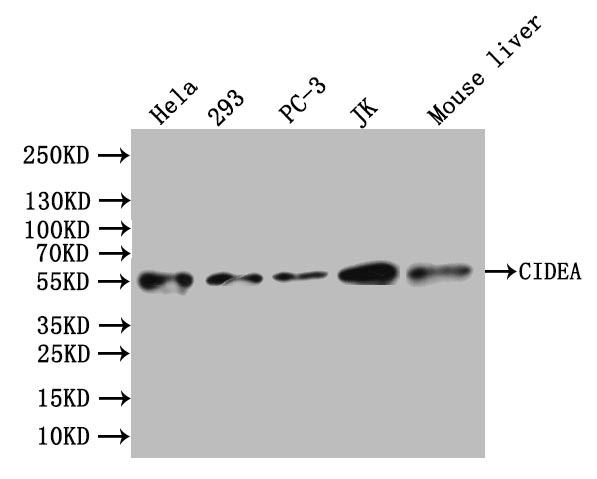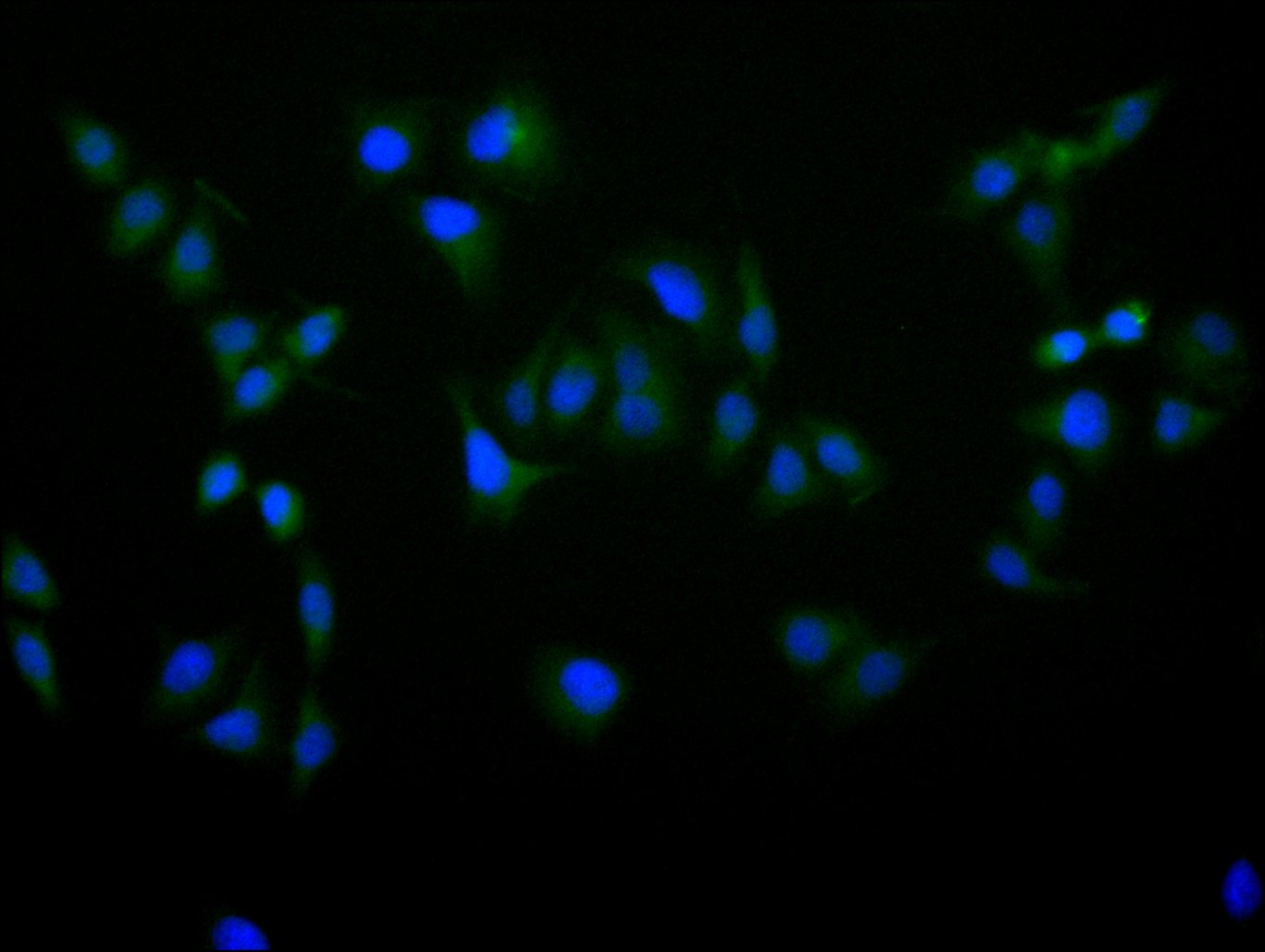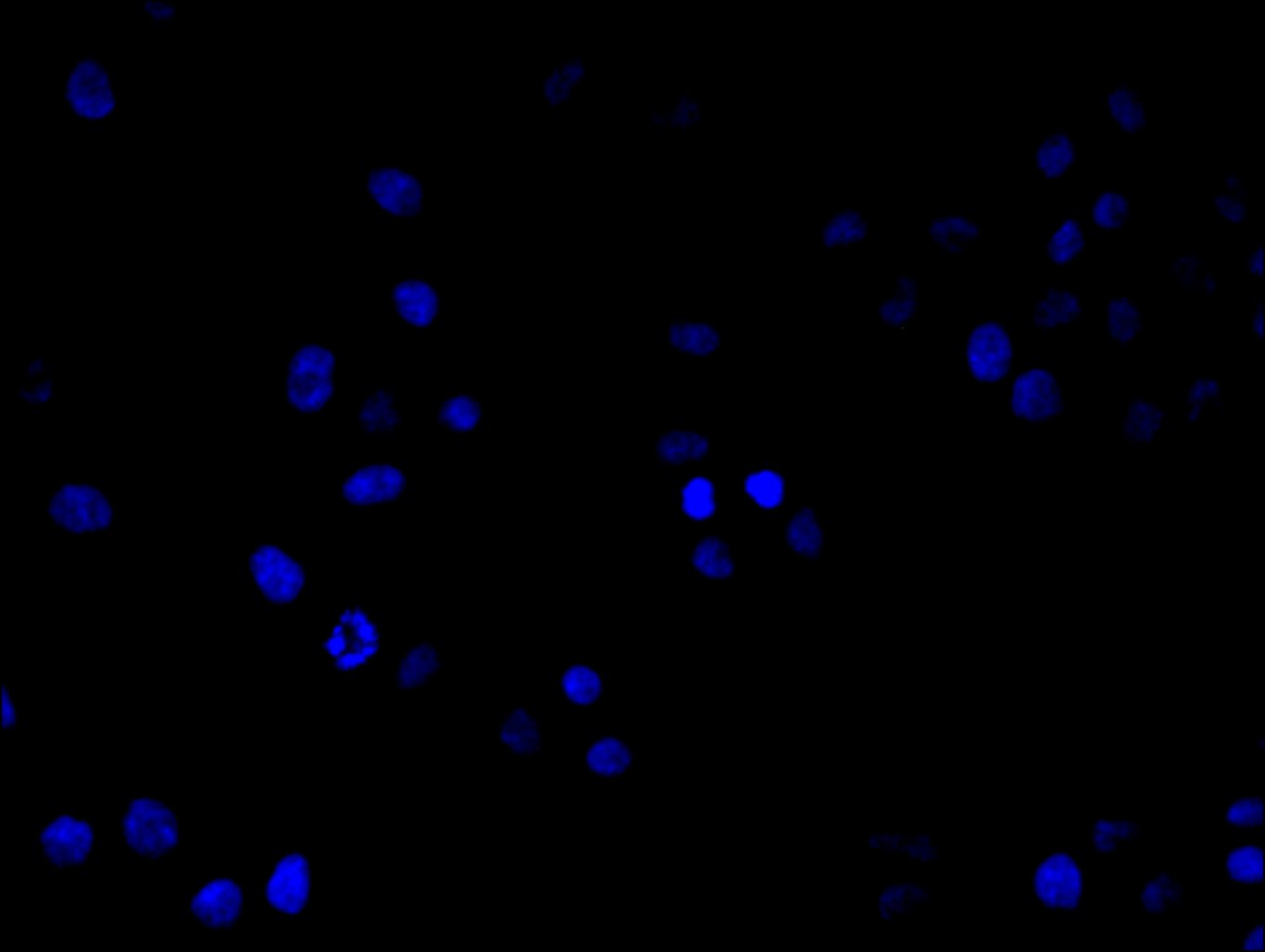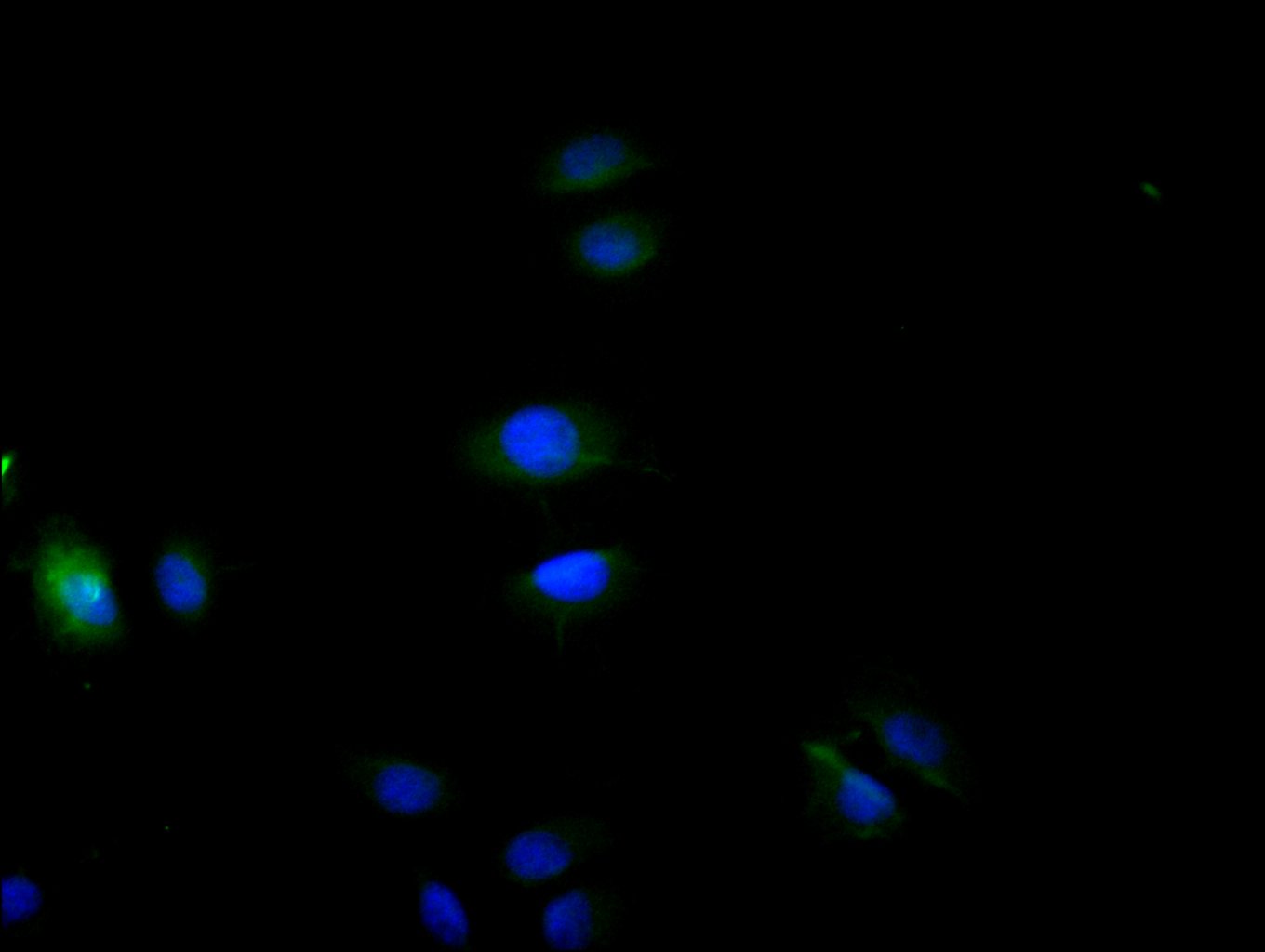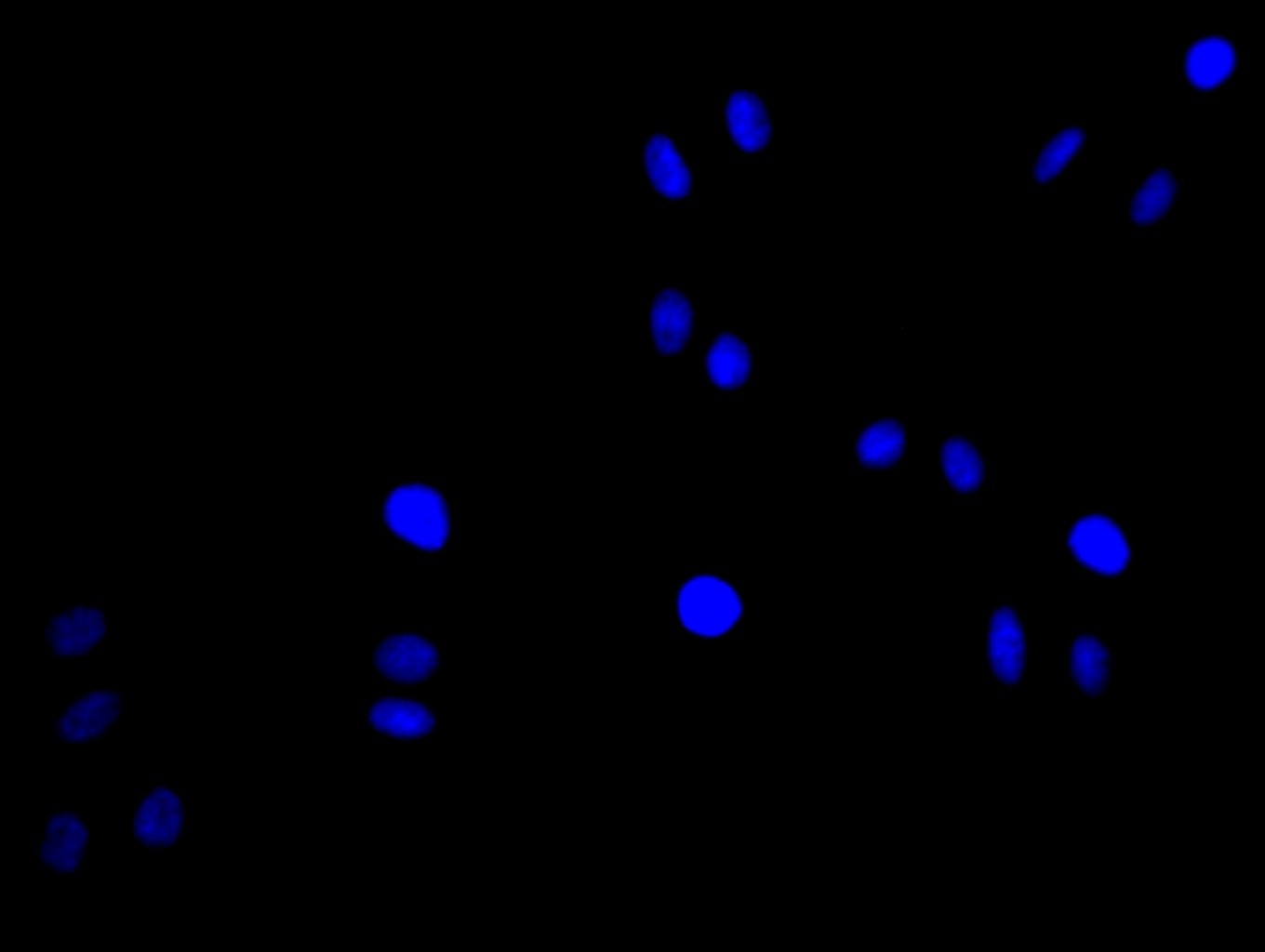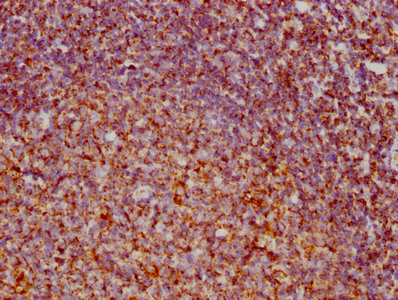-
货号:CSB-PA005431LA01HU
-
规格:¥440
-
促销:
-
图片:
-
Western Blot
Positive WB detected in: Mouse liver tissue
All lanes: CIDEA antibody at 3.4μg/ml
Secondary
Goat polyclonal to rabbit IgG at 1/50000 dilution
Predicted band size: 25 kDa
Observed band size: 25 kDa -
Immunofluorescent analysis of Hela cells using CSB-PA005431LA01HU at dilution of 1:100 and Alexa Fluor 488-congugated AffiniPure Goat Anti-Rabbit IgG(H+L)
-
Immunofluorescence staining of Hela cell with CSB-PA005431LA01HU at 1:30, counter-stained with DAPI. The cells were fixed in 4% formaldehyde and blocked in 10% normal Goat Serum. The cells were then incubated with the antibody overnight at 4C. The secondary antibody was Alexa Fluor 488-congugated AffiniPure Goat Anti-Rabbit IgG(H+L).
-
Immunofluorescence staining of Hela cell with 5% goat serum, counter-stained with DAPI. The cells were fixed in 4% formaldehyde and blocked in 10% normal Goat Serum. The cells were then incubated with the antibody overnight at 4C. The secondary antibody was Alexa Fluor 488-congugated AffiniPure Goat Anti-Rabbit IgG(H+L).
-
Immunofluorescence staining of A549 cell with CSB-PA005431LA01HU at 1:30, counter-stained with DAPI. The cells were fixed in 4% formaldehyde and blocked in 10% normal Goat Serum. The cells were then incubated with the antibody overnight at 4C. The secondary antibody was Alexa Fluor 488-congugated AffiniPure Goat Anti-Rabbit IgG(H+L).
-
Immunofluorescence staining of A549 cell with 5% goat serum, counter-stained with DAPI. The cells were fixed in 4% formaldehyde and blocked in 10% normal Goat Serum. The cells were then incubated with the antibody overnight at 4C. The secondary antibody was Alexa Fluor 488-congugated AffiniPure Goat Anti-Rabbit IgG(H+L).
-
-
其他:
产品详情
-
产品名称:Rabbit anti-Homo sapiens (Human) CIDEA Polyclonal antibody
-
Uniprot No.:O60543
-
基因名:CIDEA
-
别名:CIDEACell death activator CIDE-A antibody; Cell death-inducing DFFA-like effector A antibody
-
宿主:Rabbit
-
反应种属:Human, Mouse
-
免疫原:Synthesized peptide derived from human protein
-
免疫原种属:Homo sapiens (Human)
-
标记方式:Non-conjugated
本页面中的产品,CIDEA Antibody (CSB-PA005431LA01HU),的标记方式是Non-conjugated。对于CIDEA Antibody,我们还提供其他标记。见下表:
-
克隆类型:Polyclonal
-
抗体亚型:IgG
-
纯化方式:Affinity-purified
-
浓度:It differs from different batches. Please contact us to confirm it.
-
保存缓冲液:Liquid in PBS containing 50% glycerol, and 0.02% sodium azide.
-
产品提供形式:Liquid
-
应用范围:ELISA, WB,IF
-
推荐稀释比:
Application Recommended Dilution WB 1:500-1:2000 IF 1:20-1:200 -
Protocols:
-
储存条件:Upon receipt, store at -20°C or -80°C. Avoid repeated freeze.
-
货期:Basically, we can dispatch the products out in 1-3 working days after receiving your orders. Delivery time maybe differs from different purchasing way or location, please kindly consult your local distributors for specific delivery time.
引用文献
相关产品
靶点详情
-
功能:Acts as a CEBPB coactivator in mammary epithelial cells to control the expression of a subset of CEBPB downstream target genes, including ID2, IGF1, PRLR, SOCS1, SOCS3, XDH, but not casein. By interacting with CEBPB, strengthens the association of CEBPB with the XDH promoter, increases histone acetylation and dissociates HDAC1 from the promoter. Binds to lipid droplets and regulates their enlargement, thereby restricting lipolysis and favoring storage. At focal contact sites between lipid droplets, promotes directional net neutral lipid transfer from the smaller to larger lipid droplets. The transfer direction may be driven by the internal pressure difference between the contacting lipid droplet pair and occurs at a lower rate than that promoted by CIDEC. When overexpressed, induces apoptosis. The physiological significance of its role in apoptosis is unclear.
-
基因功能参考文献:
- Cidea, unexpectedly, functions molecularly as an indirect inhibitor of thermogenesis via inhibition of UCP1 activity. PMID: 27923808
- These data establish a functional role for Cidea and suggest that, in humans, the association between Cidea levels in white fat and metabolic health is not only correlative but also causative. PMID: 26118629
- Since Cide-A protein plays a role in the development of metabolic diseases such as obesity, metabolic syndrome, type 2 diabetes and their vascular complications, CIDE -A gene and protein are potential therapeutic targets for these diseases. PMID: 24413203
- The lowest mean relative of the gene expression for CIDE-A was observed in the group of obese patients with aortic aneurysm and lipid disorders PMID: 25720106
- the association of tag-single nucleotide polymorphisms and haplotype structures of the CIDEA gene with obesity in a Han Chinese population, was investigated. PMID: 24057179
- CIDE proteins expression correlate with tumor and survival characteristics in patients with renal cell carcinoma. PMID: 23475172
- Insulin regulates CIDEA and CIDEC expression via PI3K, and it regulates expression of each protein via Akt1/2-and JNK2-dependent pathways, respectively, in human adipocytes. PMID: 21636835
- The proportion of subjects with CIDEA) gene V115F (G/T) polymorphism with phenotypes of metabolic syndrome in a Chinese population was significantly higher based on genotype, in the order: GG PMID: 21106268
- CIDEA binds to liver X receptors and regulates their activity in vitro. PMID: 21315073
- These data indicate that the carboxy-terminal domain of Cidea directs lipid droplet targeting, lipid droplet clustering, and triglyceride accumulation, whereas the amino terminal domain is required for Cidea-mediated development of enlarged lipid droplets PMID: 20810722
- CIDEC is essential for the differentiation of adipose tissue PMID: 20945533
- These results suggest that CIDEA and CIDEC are novel genes regulated by insulin in human adipocytes and may play key roles in the effects of insulin, such as anti-apoptosis and lipid droplet formation. PMID: 20154362
- Methylation status of CIDEA, HAAO and RXFP3 had significant association with microsatellite instability in endometrial tumors. PMID: 20211485
- We propose an important and human-specific role for CIDEA in lipolysis regulation and metabolic complications of obesity. PMID: 15919794
- results support a role for cell death-inducing DFFA (DNA fragmentation factor-alpha)-like effector A (CIDEA) alleles in human obesity PMID: 16186410
- deglycosylation of CIDE-A correlated with enhanced nuclear export of the protein, and that high level of nonglycosylated CIDE-A inhibited TGFbeta1-dependent cell death. PMID: 17080483
- No dysregulation of CIDEA expression was observed in individuals with the metabolic syndrome PMID: 17895319
- The expression of the CIDE-A gene was regulated by CpG methylation of the promoter region. PMID: 18033804
- F allele of the CIDEA gene may serve as a risk factor for phenotypes related to metabolic syndrome in Japanese men. PMID: 18328351
- Cidea and other lipid droplet proteins define a novel, highly regulated pathway of triglyceride deposition in human WAT. PMID: 18509062
- CIDEa is sequestered in mitochondria while transfer of this potentially dangerous protein from mitochondria into nucleus intensifies or even initiates apoptosis. PMID: 18645223
- CIDEA is involved in adipose tissue loss in cancer cachexia and this may, at least in part, be due to its ability to inactivate PDC, thereby switching substrate oxidation in human fat cells from glucose to FAs. PMID: 19010897
显示更多
收起更多
-
相关疾病:In omental and subcutaneous adipose tissue of obese patients matched for BMI, expression levels correlate with insulin sensitivity. Expression is increased 5-6 fold in the group of patients with high insulin sensitivity, compared to the insulin-resistant group. This observation is consistent with the idea that triglyceride storage in adipocytes plays an important role in sequestering triglycerides and fatty acids away from the circulation and peripheral tissues, thus enhancing insulin sensitivity in liver and muscle.
-
亚细胞定位:Lipid droplet. Nucleus.
-
组织特异性:Expressed in omental and subcutaneous adipose tissue (at protein level).
-
数据库链接:
HGNC: 1976
OMIM: 604440
KEGG: hsa:1149
STRING: 9606.ENSP00000320209
UniGene: Hs.249129
Most popular with customers
-
-
YWHAB Recombinant Monoclonal Antibody
Applications: ELISA, WB, IF, FC
Species Reactivity: Human, Mouse, Rat
-
-
-
-
-
-
VDAC1 Recombinant Monoclonal Antibody
Applications: ELISA, WB, IHC
Species Reactivity: Human, Mouse, Rat


